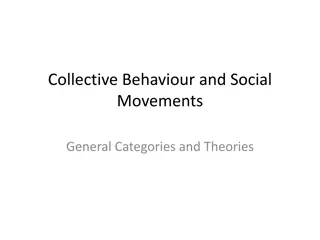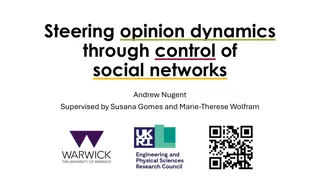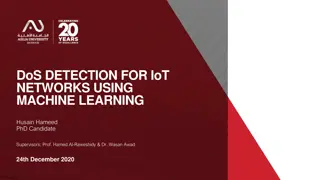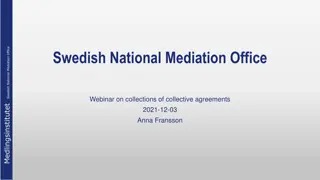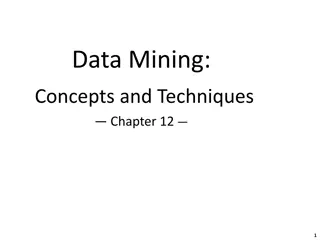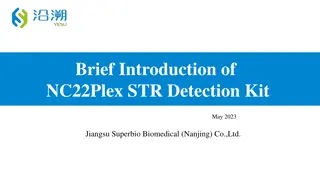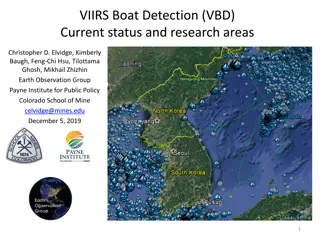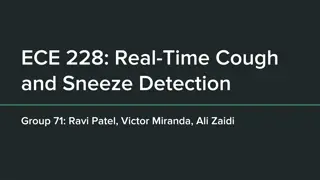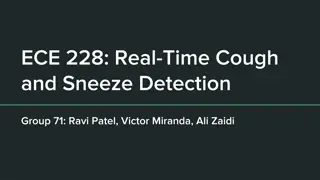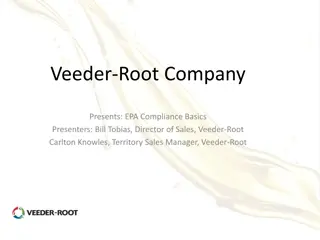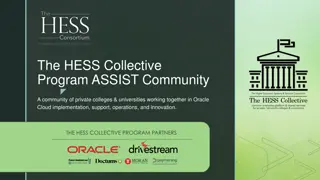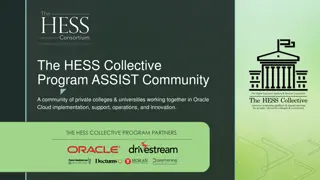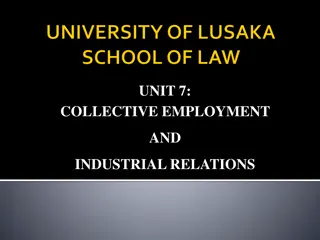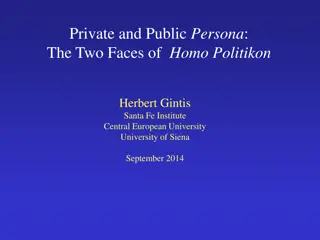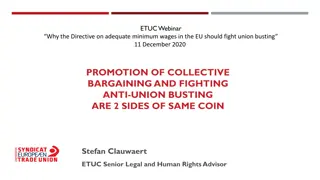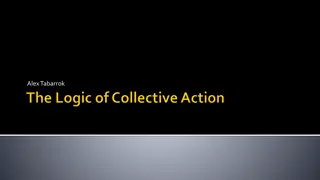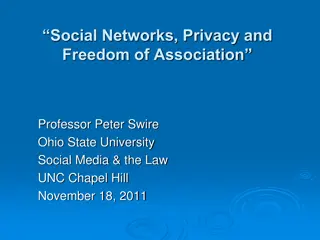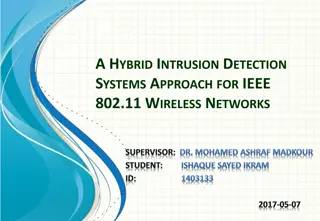Collective Spammer Detection in Evolving Social Networks
Exploring the growth of spam in social networks, this study highlights the challenges posed by spammers and the need for collective detection mechanisms. With insights on spam trends, interaction methods, and user profiles, it sheds light on the evolving landscape of social network spam.
Download Presentation

Please find below an Image/Link to download the presentation.
The content on the website is provided AS IS for your information and personal use only. It may not be sold, licensed, or shared on other websites without obtaining consent from the author. Download presentation by click this link. If you encounter any issues during the download, it is possible that the publisher has removed the file from their server.
E N D
Presentation Transcript
+ Collective Spammer Detection in Evolving Multi-Relational Social Networks Shobeir Fakhraei (University of Maryland) James Foulds (University of California, Santa Cruz) Madhusudana Shashanka (if(we) Inc., Currently Niara Inc.) Lise Getoor (University of California, Santa Cruz)
2 Spam in Social Networks Recent study by Nexgate in 2013: Spam grew by more than 300% in half a year
3 Spam in Social Networks Recent study by Nexgate in 2013: Spam grew by more than 300% in half a year 1 in 200 social messages are spam
4 Spam in Social Networks Recent study by Nexgate in 2013: Spam grew by more than 300% in half a year 1 in 200 social messages are spam 5% of all social apps are spammy
5 Spam in Social Networks What s different about social networks? Spammers have more ways to interact with users
6 Spam in Social Networks What s different about social networks? Spammers have more ways to interact with users Messages, comments on photos, winks,
7 Spam in Social Networks What s different about social networks? Spammers have more ways to interact with users Messages, comments on photos, winks, They can split spam across multiple messages
8 Spam in Social Networks What s different about social networks? Spammers have more ways to interact with users Messages, comments on photos, winks, They can split spam across multiple messages More available info about users on their profiles!
9 Spammers are getting smarter! Traditional Spam: Want some replica luxury watches? Click here: http://SpammyLink.com George Shobeir
10 Spammers are getting smarter! Traditional Spam: Want some replica luxury watches? Click here: http://SpammyLink.com George [Report Spam] Shobeir
11 Spammers are getting smarter! Traditional Spam: (Intelligent) Social Spam: Want some replica luxury watches? Click here: http://SpammyLink.com Hey Shobeir! Nice profile photo. I live in Bay Area too. Wanna chat? George Mary [Report Spam] Shobeir Shobeir
12 Spammers are getting smarter! Traditional Spam: (Intelligent) Social Spam: Want some replica luxury watches? Click here: http://SpammyLink.com Hey Shobeir! Nice profile photo. I live in Bay Area too. Wanna chat? George Mary [Report Spam] Sure! :) Shobeir Shobeir
13 Spammers are getting smarter! Traditional Spam: (Intelligent) Social Spam: Want some replica luxury watches? Click here: http://SpammyLink.com Hey Shobeir! Nice profile photo. I live in Bay Area too. Wanna chat? George Mary [Report Spam] Sure! :) Shobeir Shobeir Realistic Looking Conversation I m logging off here., too many people pinging me! I really like you, let s chat more here: http://SpammyLink.com Mary
14 Tagged.com Founded in 2004, is a social networking site which connects people through social interactions and games Over 300 million registered members Data sample for experiments (on a laptop): 5.6 Million users (3.9% Labeled Spammers) 912 Million Links
15 Social Networks: Multi-relational and Time-Evolving t(1) t(2) t(5) t(10) t(6) t(4) t(7) t(8) t(3) t(11) t(9)
16 Social Networks: Multi-relational and Time-Evolving Legitimate users t(1) t(2) t(5) t(10) t(6) t(4) t(7) t(8) t(3) t(11) t(9)
17 Social Networks: Multi-relational and Time-Evolving Legitimate users t(1) t(2) Spammers t(5) t(10) t(6) t(4) t(7) t(8) t(3) t(11) t(9)
18 Social Networks: Multi-relational and Time-Evolving Legitimate users t(1) t(2) Spammers t(5) t(10) t(6) t(4) t(7) t(8) t(3) t(11) t(9) Link = Action at time t Actions = Profile view, message, poke, report abuse, etc
19 Social Networks: Multi-relational and Time-Evolving t(1) t(2) t(5) t(10) t(6) t(4) t(7) t(8) t(3) t(11) t(9) Link = Action at time t Actions = Profile view, message, poke, report abuse, etc
20 Social Networks: Multi-relational and Time-Evolving Profile view t(1) t(2) t(5) t(10) t(6) t(4) t(7) t(8) t(3) t(11) t(9) Link = Action at time t Actions = Profile view, message, poke, report abuse, etc
21 Social Networks: Multi-relational and Time-Evolving Message Profile view t(1) t(2) t(5) t(10) t(6) t(4) t(7) t(8) t(3) t(11) t(9) Link = Action at time t Actions = Profile view, message, poke, report abuse, etc
22 Social Networks: Multi-relational and Time-Evolving Message Profile view t(1) t(2) t(5) t(10) t(6) t(4) t(7) t(8) t(3) t(11) t(9) Poke Link = Action at time t Actions = Profile view, message, poke, report abuse, etc
23 Social Networks: Multi-relational and Time-Evolving Message Profile view t(1) t(2) t(5) t(10) t(6) Report spammer t(4) t(7) t(8) t(3) t(11) t(9) Poke Link = Action at time t Actions = Profile view, message, poke, report abuse, etc
24 Our Approach Predict spammers based on: Graph structure Action sequences t(1) t(2) Reporting behavior t(5) t(10) t(6) t(4) t(7) t(8) t(3) t(11) t(9)
25 Our Approach Predict spammers based on: Graph structure Action sequences t(1) t(2) Reporting behavior t(5) t(10) t(6) t(4) t(7) t(8) t(3) t(11) t(9)
26 Graph Structure Feature Extraction Are you interested? Pagerank, K-core, Graph coloring, Triangle count, Connected components, In/out degree Meet Me Play Pets Friend Request Message Wink Report Abuse Graphs for each relation
27 Graph Structure Feature Extraction Features Are you interested? Pagerank, K-core, Graph coloring, Triangle count, Connected components, In/out degree Meet Me Play Pets Friend Request Message Wink Report Abuse Graphs for each relation
28 Graph Structure Features Extract features for each relation graph es for each of 10 rel PageRank Degree statistics Total degree In degree Out degree k-Core Graph coloring Connected components Triangle count (8 features for each of 10 relations)
29 Graph Structure Features Extract features for each relation graph es for each of 10 rel PageRank Degree statistics Total degree In degree Out degree k-Core Graph coloring Connected components Triangle count (8 features for each of 10 relations)
30 Graph Structure Features Extract features for each relation graph es for each of 10 rel PageRank Degree statistics Total degree In degree Out degree k-Core Graph coloring Connected components Triangle count (8 features for each of 10 relations)
31 Graph Structure Features Extract features for each relation graph es for each of 10 rel PageRank Degree statistics Total degree In degree Out degree k-Core Graph coloring Connected components Triangle count (8 features for each of 10 relations)
32 Graph Structure Features Extract features for each relation graph es for each of 10 rel PageRank Degree statistics Total degree In degree Out degree k-Core Graph coloring Connected components Triangle count (8 features for each of 10 relations)
33 Graph Structure Features Extract features for each relation graph es for each of 10 rel PageRank Degree statistics Total degree In degree Out degree k-Core Graph coloring Connected components Triangle count (8 features for each of 10 relations)
34 Graph Structure Features Extract features for each relation graph es for each of 10 rel PageRank Degree statistics Total degree In degree Out degree k-Core Graph coloring Connected components Triangle count (8 features for each of 10 relations)
35 Graph Structure Features Extract features for each relation graph es for each of 10 rel PageRank Degree statistics Total degree In degree Out degree X k-Core Graph coloring Connected components Triangle count (8 features for each of 10 relations)
36 Graph Structure Features Extract features for each relation graph es for each of 10 rel PageRank Viewing profile Friend requests Degree statistics Total degree In degree Out degree Message Luv Wink X Pets game k-Core Buying Wishing Graph coloring MeetMe game Connected components Yes No Triangle count Reporting abuse (8 features for each of 10 relations)
37 Graph Structure Features Viewing profile Reporting abuse Graph Coloring Graph Coloring Triangle Count Triangle Count Out-Degree Out-Degree PageRank PageRank In-Degree In-Degree k-Core k-Core Classification method: Gradient Boosted Trees
38 Graph Structure Features Experiments AU-PR AU-ROC 1 Relation, 8 Feature types 0.187 0.004 0.803 0.001 10 Relations, 1 Feature type 0.285 0.002 0.809 0.001 10 Relations, 8 Feature types 0.328 0.003 0.817 0.001 Multiple relations/features better performance!
39 Graph Structure Features Experiments AU-PR AU-ROC 1 Relation, 8 Feature types 0.187 0.004 0.803 0.001 10 Relations, 1 Feature type 0.285 0.002 0.809 0.001 10 Relations, 8 Feature types 0.328 0.003 0.817 0.001 Multiple relations/features better performance!
40 Graph Structure Features Experiments AU-PR AU-ROC 1 Relation, 8 Feature types 0.187 0.004 0.803 0.001 10 Relations, 1 Feature type 0.285 0.002 0.809 0.001 10 Relations, 8 Feature types 0.328 0.003 0.817 0.001 Multiple relations/features better performance!
41 Graph Structure Features Experiments AU-PR AU-ROC 1 Relation, 8 Feature types 0.187 0.004 0.803 0.001 10 Relations, 1 Feature type 0.285 0.002 0.809 0.001 10 Relations, 8 Feature types 0.328 0.003 0.817 0.001 Multiple relations/features better performance!
42 Our Approach Predict spammers based on: Graph structure Action sequences t(1) t(2) Reporting behavior t(5) t(10) t(6) t(4) t(7) t(8) t(3) t(11) t(9)
43 Sequence of Actions Sequential Bigram Features: Short sequence segment of 2 consecutive actions, to capture sequential information User1 Actions: Message, Profile_view, Message, Friend_Request, .
44 Sequence of Actions Mixture of Markov Models (MMM): A.k.a. chain-augmented, tree-augmented naive Bayes
45 Sequence of Actions Bigram Features Chain Augmented NB +
46 Sequence of Actions Experiments AU-PR AU-ROC Bigram Features 0.471 0.004 0.859 0.001 MMM 0.246 0.009 0.821 0.003 Bigram + MMM 0.468 0.012 0.860 0.002 Little benefit from MMM (although little overhead)
47 Results Precision-Recall ROC We can classify 70% of the spammers that need manual labeling with about 90% accuracy
48 Deployment and Example Runtimes We can: Run the model on short intervals, with new snapshots of the network Update the features as events occur Example runtimes with Graphlab CreateTMon a Macbook Pro: 5.6 million vertices and 350 million edges: PageRank: 6.25 minutes Triangle counting: 17.98 minutes k-core: 14.3 minutes
49 Our Approach Predict spammers based on: Graph structure Action sequences t(1) t(2) Reporting behavior t(5) t(10) t(6) t(4) t(7) t(8) t(3) t(11) t(9)
50 Refining the abuse reporting systems Abuse report systems are very noisy People have different standards Spammers report random people to increase noise Personal gain in social games Goal is to clean up the system using: Reporters previous history Collective reasoning over reports



